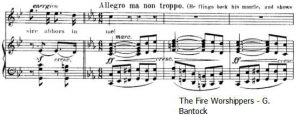By Guest Contributor Josh Liu
The Fire Worshippers (published 1892), a dramatic cantata for solo voices chorus and orchestra, is written ambitiously by the hand of then student-composer Granville Bantock. As a piece that is derived from Thomas Moore’s oriental romance Lalla Rookh (1817), Bantock modernises the musical response to the story and establishes a great force into the music.
Bantock is a prolific composer who constantly changes his musical language in an unrecognisable manner. However, the Wagnerian compositional style remains as the main influence in Bantock which can be identified in The Fire Worshippers. Compared with songs based on Lalla Rookh that came out within a few years of Moore’s 1817 poem (for example, “‘Twas his own voice” by Sir John Stevenson), Bantock’s work shares little or no similarities. The piece is more elaborate and is written in a concert style. It is not difficult to observe the gestures from all voices; Bantock clearly drew on the strength of each character in the vocal parts. Like most late romantic pieces, The Fire Worshippers is richly orchestrated and involves notably wide-ranging melodic lines.
It is interesting to see how the musical response to Lalla Rookh develops. Composers are working with the same story-line, but it encourages different interpretations as the nineteenth century progresses. What used to be a soothing type of storytelling now becomes dramatic. Having a huge orchestra boosts every dramatic moment more effectively. To name an example, in Scene Five, when Hinda (an Arab princess in war-torn Persia, depicted by a soprano) cries ‘No rest for me, while danger’s nigh,’ the music suddenly becomes very loud with a more urgent tempo marking ‘Molto Andante’ (from the preceding ‘Largo’). The percussion offers a forceful sound on top of the thick texture achieved by strings, woodwinds and brass.
The demand in this piece is very high — as a multi-movement cantata for chorus, vocal soloists and orchestra, it is quite lengthy and substantial as compared with the short songs written for piano and voice that Moore’s poem inspired in the 1810s and ’20s. The first review of the Overture to The Fire Worshippers as performed at the Royal Academy of Music, London, simply praised Bantock’s modern interpretation of the story for being “bold, and the orchestration picturesque” The Fire Worshippers by Bantock displays vivid images through his compositional technique and orchestration. He offers a good representation of Moore’s story, entering into its ambience and variety, perhaps in a more convincing manner than Moore’s immediate contemporaries managed to do.
References
Bantock, Granville, The Fire Worshippers, Novello’s original octavo edition, London: Novello & Company Limited, 1892 (Score accessed 10th April 2017).
“Royal Academy of Music.” The Musical Times and Singing Class Circular 32.575 (1 January 1891): 23.


